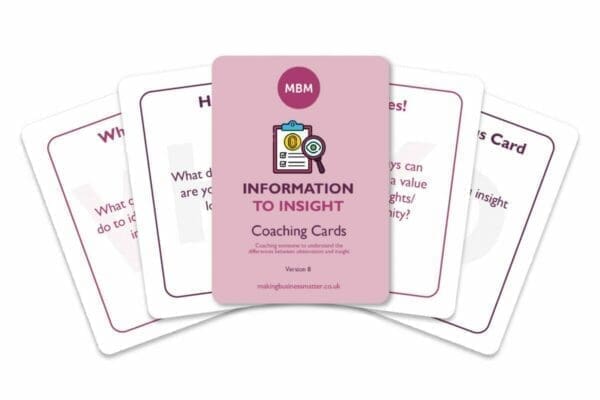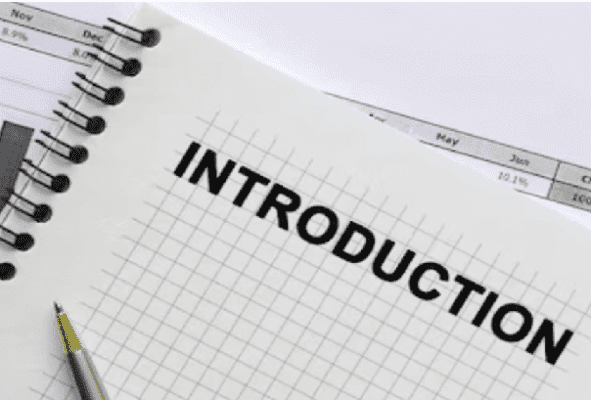Here’s How to Write a Report for Managers
Why do report writing training? Writing a report can often feel overwhelming. It’s not always easy to know how to present the most important information concisely and effectively.
If you’re looking to hone your report-writing skills and learn how to write a report that will get praised or noticed by your manager, then this blog is the perfect solution. Even better, this is not a lengthy course. Plus this is free.
This will help you to structure, organise, and write reports that are clear, concise, and engaging. You will learn how to effectively communicate complex information, how to use data to support your points, and how to ensure your report is impactful and memorable.
This blog will assist you in writing reports that stand out and capture attention, helping you distinguish yourself from the rest.

>> Information to Insight Coaching Cards <<
>> Access on Amazon <<
What Are Reports?
Reports are documents that compile and summarise information to help people make decisions. They can inform people about a particular topic or present the results of an investigation or study. Reports can include text, images, charts, and other data to comprehensively view the subject.

What Are the Types of Reports?
There are many different types of reports, each serving a different purpose.
- Business reports are used to provide information about a company’s operations and performance.
- Research reports are used to document the results of scientific or other investigations.
- Technical reports are used to explain the details of a new product or technology.
- Market reports provide information about the current state of a particular industry or sector.
- Audit reports assure that financial statements are accurate; and
- Feasibility reports provide information about the potential of a project or venture.
No matter the type, reports provide an essential service in helping people understand and make decisions. All in all, reports are an important part of any organisation’s decision-making process and should be used to their fullest potential.
How to Write a Report?

Sticky Learning ® is 7 times more effective than 1-day training courses. Plus, you will get a Chain of Evidence proving your Return on Investment. Discover soft skills training that changes behaviours long term.

1. Make a Draft of Your Information
Drafting information for a report is an important step in the process of writing a successful report. It helps the writer to organise their thoughts, find the relevant facts, and to ensure the accuracy of their writing.
When drafting information for a report, it is important to determine the purpose of the report, the specific audience you are writing for, and the key points you want to make.
For example, if you are writing a report on the impact of climate change on the environment, you would want to start by researching the facts and figures related to the topic. You would want to make sure that the information is written clearly and coherently, using language that is appropriate for the target audience.
When preparing to draft the information for a report, it is important to take the time to ensure that the information is clear and based on facts. It is important to use reliable sources when including research and data in the report.
2. Make a Structure of Your Report
The structure is an essential part of any report and can make the difference between an effective document and one that falls flat. Having a strong structure is key to ensuring that the report is easily readable, organised, and delivers the intended message.
When it comes to making a structure for your report, it is important to consider the purpose and audience of the report. This will help you determine what components should be included in the structure and how to organise them.
For example, if your report is intended to inform a manager of a business, you may want to start with an executive summary that outlines the main points. Then, you could include a brief introduction to the report, followed by the main body that presents the data and findings, and finally, a conclusion that summarises the key points.
You may want to use headings and subheadings to break up the sections, numbered lists and bullet points to make it easier to read, and images or diagrams to help illustrate the points. Structuring the report in this way can make it more engaging for the reader and help convey the idea more effectively.

3. Title
The title of a report is a crucial element of any written work. It is the first thing that a reader will notice and can make a lasting impression. A great title will make your report stand out and draw the reader’s attention. It should indicate the content of the report and should be clear and concise.
An effective title should be informative and should accurately reflect the contents of the report. It should also be catchy and engaging, to ensure the reader takes notice.
For example, if you are writing a report on how to reduce costs in the organisation, the title “Cost Reduction Strategies for the Organisation” is a great choice.
When writing the title for a report to the manager, you should be sure to keep the manager’s interests in mind. Keep the title short and to the point, but also make sure to capture the essence of the report.
To make sure your title is effective and engaging, we’ve included these tips to consider as part of this report writing training:
- Use words that are relevant to the topic of the report
- Make sure the title is brief and easy to read
- Avoid nonsense and overly technical language
- Use active words to create a sense of urgency
4. Brief Summary
A summary is an essential part of report writing, as it allows the reader to get a quick overview of the entire document. It provides a brief overview of the main topics and findings and is usually written for a manager or other higher-level executive.
It should be kept short and to the point, and must include the following elements:
- The purpose of the report
- The key findings or results
When writing a summary, it is important to keep it concise and relevant to the report. It should highlight the most important points in the report, and provide a summary of the most important findings. If you are short on time and wanted to get a summary in seconds then there are several websites that summarise text and help in writing a brief summary.
5. Table of Content
Creating a table of contents for a report is an essential step in the process of report writing. It helps readers quickly identify the topics covered in the report and quickly find the relevant information they need.
A table of contents also serves as a roadmap for the entire report, enabling readers to get an overview of the structure of the document.
When crafting a table of contents for a report, ensure you organise it logically and include enough detail to give readers an idea of the covered topics. Additionally, it is important to be as specific as possible. Make sure to include all major topics and subtopics.
6. Introduction
Writing an introduction is another important step in the process of report writing. An introduction serves to outline the main purpose of the report and provide readers with an overview of the information they can expect to find. It should be clear, concise, and appealing, as it is the first thing readers will look at.
When writing an introduction, there are several points to consider. First, it should include the scope of the report, the objectives, and any background information. The introduction should also provide an overview of the report’s structure and content.

7. Main Body of the Report
Once you are done with the preamble, you have to get started with the actual report itself.
Now, there isn’t a fixed format or layout that you have to follow for every report that you write. Depending on the contents of the report as well as the topic it covers, there are different elements that you have to include in it.
For example, if the report pertains to some sort of statistical analysis, you will have to enter the data in tabular form. On the other hand, if the report pertains to explanations and delineations, then the text will be in the form of paragraphs and sentences.
However, regardless of the type of report it is, you have to take care of the following points:
- Make sure that there are no grammar or spelling errors in any of the content
- Make sure that the content is readable
- Make sure that there are no formatting errors i.e., small font size or less line spacing etc.
- Make sure that the different elements and components of the report are properly separated
We’ll elaborate on these types of points properly in the “Tips” section but these are some that you can keep in mind at this point in this report writing training.
8. Conclusion and Recommendations
The conclusion and recommendation of a report are essential elements that provide the reader with a clear understanding of the research findings and their implications. Specifically, the conclusion summarises the research findings and their implications, while the recommendation outlines the best course of action based on the research findings.
The conclusion and recommendation are important for several reasons. Firstly, the conclusion gives a full overview of the research findings and their implications, allowing the reader to quickly and easily understand the main points of the report. Secondly, the recommendation can provide the reader with practical guidance on how to address the issue or problem addressed in the report.
For example, a report on employee engagement might conclude that there are several areas where employee engagement can be improved and could then recommend particular strategies to increase engagement.
The conclusion can be used to identify areas of further research, while the recommendation can be used to suggest potential changes in policy or practice.
For example, a report on reducing poverty might conclude that more financial support for low-income families is needed and could then recommend the implementation of certain measures to increase financial support.
What are the 5 C’s of Good Report Writing?
Writing a good report doesn’t have to be a daunting task. With the right tips, you can write a concise and engaging report that covers all the important information.

This report writing training wouldn’t be complete without this section. So here are some tips to help you write a good report:
#1. Clear – Easy-to-read Content
Easy-to-read content is content that is well-organised and easy to understand. It should include simple language and clear paragraphs that make it easy for readers to quickly absorb the information.
For example, a good report should begin with an introduction that outlines the purpose of the report, followed by clearly defined sections that provide the necessary information.
Writing easy-to-read content starts with creating a well-structured outline that breaks down the report into sections and subsections. This will help ensure that the report is organised and easy to follow.
Other than the textual arrangement, another thing that makes content easy to read is the choice of words that you use in it. Using easily understandable words and phrases is also key to better readability. You can also take help from a website that paraphrases text to make your content flow better.
#2. Concise
Concise and formal language is a type of writing that is direct and to the point. It avoids unnecessary details and uses clear and precise words to convey the desired message.
Writing in a concise and formal style requires careful consideration of the language used and the tone of the piece. To achieve a concise and formal writing style, use short and simple sentences, avoid jargon, and use an active voice.
Avoid using long and complicated words and phrases that could confuse the reader. Make sure to use the same tense and verb throughout the report. Employ proper grammar and punctuation to present the report in a professional manner.
This will make sure that the reader can quickly comprehend the information that you are trying to convey.
#3. Complete
It can be challenging to know how much or how little to include into some reports. We have already mentioned about being concise for ease of understanding. However, it is important that all essential information is included.
This could mean the inclusion of graphs or images to highlight a section of your report. Where necessary, include these. It will reinforce the information contained in your report.
Also, different readers like different writing styles. Therefore, graphs and images will have more impact for some readers than the main content.
Have a mix within your content. That way, you will reach a wider audience in terms of interest and understanding.
#4: Consistent
Before submitting a report, you must ensure that what you are submitting flows well and is professional. This will mean proofreading and editing your content carefully.
Proofreading and editing the report is an important step in this report writing training to ensure that the manager receives a professional and accurate final report. It is important to proofread and edit the report carefully to ensure grammar, punctuation, and spelling.
For example, if a report contains a table or graph, it is important to proofread and edit the table or graph to ensure that it is accurate and easy to understand. It is important to look for any typos, incorrect grammar, or other errors that may detract from the overall readability of the report.
When proofreading and editing the report, it is important to read the report thoroughly, paying special attention to any details that may be incorrect or unclear. Additionally, have a colleague or friend review the report is advisable, as they might identify errors or inconsistencies overlooked during the initial proofreading. Also, use a grammar checker to ensure accurate sentence structures.
#5: Courteous
Finally, when considering your report style, keep note of the style of writing you are using. For example, this report could be about something very close to your heart, such as improvements in safety or staff issues.
However, throughout the report, stick with the facts. Do not use the report to accuse individuals of wrongdoing. Instead, use the report to highlight your findings and recommendations. This way, you get your point across in a professional and courteous way. Also, people will pay more attention to your content with this style of delivery.
Final Words
In the end, writing reports for managers can be a complex task, but with practice, anyone can learn to write effective and engaging reports. By understanding the basics of report writing, from understanding the information for a report to formatting and structuring the content, you will be able to quickly and easily craft reports. This report writing training will give you the confidence to create reports that convey your intended message and that your managers will receive well.
Updated: September 2023 by Ailish O’Rourke-Henriette




